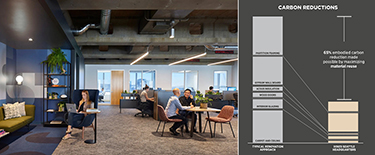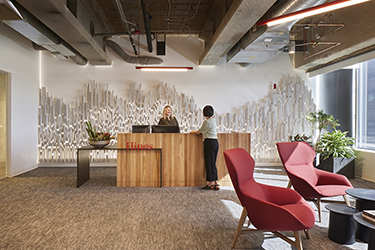|
Subscribe / Renew |
|
|
Contact Us |
|
| ► Subscribe to our Free Weekly Newsletter | |
| home | Welcome, sign in or click here to subscribe. | login |
Environment
| |
 |
April 25, 2024
Toward a path to zero carbon: building renovations and circular economy principles
LMN ARCHITECTS

Chen
|

Schwartzhoff
|
How does the building industry align around radical, pragmatic decarbonization? Along with addressing climate pollution from energy use, we also must address the climate pollution that comes from manufacturing construction materials like concrete, steel, and even carpet and furniture. Known as embodied carbon, this pollution is around 20% of global greenhouse gases, and represents the next frontier in decarbonization. The solution toolkit includes building reuse and circular economy, sustainably-sourced mass timber, zero-carbon concrete and steel, structural materials efficiency, agricultural-waste biogenic materials and all-electric construction vehicles.
Since 2020, LMN Architects has led an industry-wide collaboration to uncover the challenges and consolidate solutions on carbon reduction through the Path To Zero Carbon series. With dozens of experts and peers involved, this provides the first comprehensive view of AEC carbon pollution and solutions.
CIRCULAR ECONOMY AS A KEY SOLUTION
Among solutions, transitioning to a circular economy is one of the most important. What is a circular economy? It means keeping materials, products and buildings in continual use instead of sending them to a landfill. From bricks and insulation to furniture and whole buildings, this means designing for timelessness, durability, and deconstruction, as well as salvaging from existing buildings, building a local refurbishment economy, and warehousing of refurbished products.
How does the circular economy impact carbon? In the case study below, buying best-in-class low carbon new products might have led to a 22% reduction in carbon, but by engaging the circular economy, the team realized a 65% embodied carbon reduction.
Materials also can have stories that contribute to design; from the old brick and reclaimed wood character we love in coffee shops to materials like ceiling tiles and workstations that can be refurbished to be indistinguishable from new. Circular economy platforms and products like Rheaply, Reseat, Davies Furniture, and Doors Unhinged already exist nationally in some product categories, and local options exist in most cities.
RETHINKING RENOVATIONS
Office renovations are often excluded by embodied carbon measurements, ratings and ESG accounting. Major certifications systems, such as LEED, allow interiors material to be excluded from embodied carbon calculations (also referred to as Life Cycle Analysis or LCA). A lack of carbon data (Environmental Product Declarations or EPDs) for interiors materials makes tracking emissions more difficult even if an owner wants to include them.
This is a huge potential oversight, as an early LMN study on interior renovations suggested that interior renovations could make up the largest percentage of embodied carbon over 60 years, larger even than building envelope and structure. Renovations have accelerated as well, and often require a restoration clause that requires tenants to remove everything from their space when their lease is up, even if carpet, walls, ceilings and furniture have a decade or two of useful life remaining.
Office furniture alone is estimated to account for over 8.5 million tons of waste per year. Worse, most office furniture is designed to function for 10-15 years, but with the short refresh cycle of seven years or less, much of this furniture is being sent to the landfill with years of useful life remaining. And with offices downsizing to accommodate a shift to hybrid work, this volume of furniture waste will likely increase over the next few years.
Can we rethink renovations? Starting with what exists already in a building and space, can existing materials and layouts remain in place as part of a thoughtful, new design instead of being removed? Can we capture the economic and carbon value of used materials instead of landfilling them?
PATH TO ZERO-CARBON INTERIORS
When Hines approached LMN for their Seattle HQ, one of the goals was to develop a repeatable system to get as close as possible to net zero carbon emissions for interior renovations. The LMN team understood that material reuse would result in the largest possible reductions, but how?
The team decided to take ownership over the existing material, first doing a walk through to identify material in good condition and with high reuse potential on and off site. A carbon accounting system was developed to account for the carbon benefit from materials reuse, incentivizing product reuse and helping to develop a hot list of priority materials for reuse. Material reuse options and carbon accounting were both consistently discussed at client design meetings.
Where removal was necessary, the team worked with the contractor to find reuse potential. For example, acoustical insulation removed from demolished interior walls was packaged up and sent to flood victims in a nearby community.
When new material was needed, the team reached out to suppliers to find unused stock; surprisingly, the team discovered that at least one supplier had a warehouse full of new, unused material that was destined for the landfill without ever being installed, which was able to supply a small area with carpet tile. For the feature wall behind the reception desk, the team worked with a local panelized wood supplier to obtain their offcuts (destined for incineration) and repurposed them into an art installation that depicts the topography of Seattle and the region.
Overall, engaging in the circular economy resulted in a reduction in embodied carbon around 65% from a typical renovation, three times the reduction possible if only new, low-carbon materials were used. While designing with the circular economy takes more design effort, it can reduce construction costs, supply chain issues, and embodied carbon. These strategies are captured in the Path To Zero Carbon series alongside many others, highlighting that there are already large levers for carbon reduction through clever design and strategic reuse.
Jenn Chen is a partner at LMN, helping to lead the firm’s materials & health applied research team, and a co-creator of its Path to Zero Carbon series. Justin Schwartzhoff is an associate at LMN and leads its in-house research group on embodied carbon and mass timber.
Other Stories:
- Creativity and innovation are hallmarks of sustainability at PDX Airport
- Curbing construction’s carbon impact from all angles
- Making old buildings new again: the case for adaptive reuse
- Promoting residential adaptive reuse in Seattle through policy
- Hiding in Plain Sight: Sustainability and resilience beyond the terminal
- Reducing embodied carbon in concrete construction
- Old building, new tricks: Designing adaptive reuse for long-lasting relevance
- Harnessing the potential of mixed-use communities
- Implementing aggressive water goals
- A blueprint for environmental responsibility in construction
- A primer on campus decarbonization in Washington




